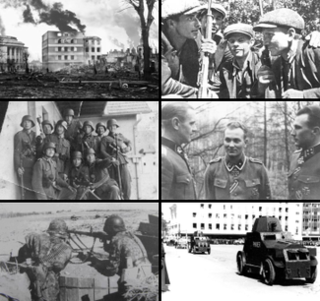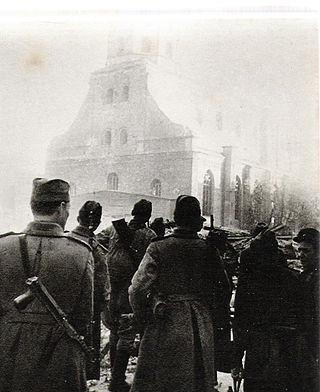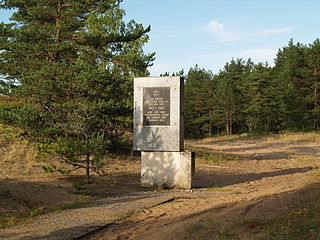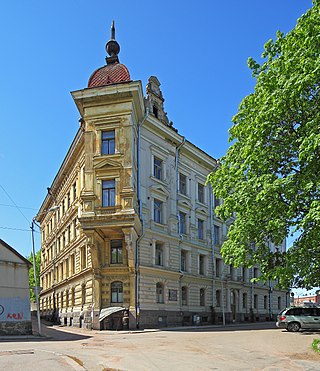
The Battle of Narva was a World War II military campaign, lasting from 2 February to 10 August 1944, in which the German Army Detachment "Narwa" and the Soviet Leningrad Front fought for possession of the strategically important Narva Isthmus.

The 20th Waffen Grenadier Division of the SS was a foreign infantry division of the Waffen-SS that served alongside but was never formally part of the Wehrmacht during World War II. According to some sources, the division was under Reichsführer-SS Heinrich Himmler's overall command but was not an integral part of the Schutzstaffel (SS). It was officially activated on 24 January 1944, and many of its soldiers had been members of the Estonian Legion and/or the 3rd Estonian SS Volunteer Brigade, which had been fighting as part of German forces since August 1942 and October 1943 respectively. Both of the preceding formations drew their personnel from German-occupied Estonia. Shortly after its official activation, widespread conscription within Estonia was announced by the German occupying authorities. The division was formed in Estonia around a cadre comprising the 3rd Estonian SS Volunteer Brigade, and was initially known as the 20th Estonian SS Volunteer Division.
The Estonian resistance movement was an underground movement to resist the occupation of Estonia by Nazi Germany, 1941–1944 during World War II. Due to the unusually benign measures implemented in Estonia by the German occupation authorities, especially in contrast to the preceding harsh Soviet occupation of Estonia (1940–1941), the movement was slower to develop effective tactics on a wide scale than in other occupied countries.

During World War II, the Estonian capital Tallinn suffered from many instances of aerial bombing by the Soviet air force and the German Luftwaffe. The first bombings by Luftwaffe occurred during the Summer War of 1941 as part of Operation Barbarossa. A number of Soviet bombing missions to then German-occupied Tallinn followed in 1942–1944.

Estonia declared neutrality at the outbreak of World War II (1939–1945), but the country was repeatedly contested, invaded and occupied, first by the Stalinist Soviet Union in 1940, then by Nazi Germany in 1941, and ultimately reinvaded and reoccupied in 1944 by the Soviet Union.

Harald Riipalu was an Estonian commander in the German Wehrmacht and the Waffen-SS during World War II. He was a recipient of the Knight's Cross of the Iron Cross of Nazi Germany.

The Riga offensive was part of the larger Baltic offensive on the Eastern Front during World War II. It took place late in 1944, and drove German forces from the city of Riga.
The Tallinn offensive was a strategic offensive by the Red Army's 2nd Shock and 8th armies and the Baltic Fleet against the German Army Detachment Narwa and Estonian units in mainland Estonia on the Eastern Front of World War II on 17–26 September 1944. Its German counterpart was the abandonment of the Estonian territory in a retreat codenamed Operation Aster.

The Tartu offensive operation, also known as the Battle of Tartu and the Battle of Emajõgi was a campaign fought over southeastern Estonia in 1944. It took place on the Eastern Front during World War II between the Soviet 3rd Baltic Front and parts of the German Army Group North.

Jürgen Wagner was a Brigadeführer in the Waffen-SS during World War II, the commander of the SS Division Nederland and was awarded the Knight's Cross of the Iron Cross with Oak Leaves.

Battle of Auvere took place in Estonia, starting on July 20, 1944 and ending on July 25. It was a part of the World War II campaign in Narva.

Estonian partisans, also called the Forest Brothers were partisans who engaged in guerrilla warfare against Soviet forces in Estonia from 1940 to 1941 and 1944 to 1978.
Estonian Auxiliary Police were Estonian police units that collaborated with the Nazis during World War II.
The 658th Eastern Battalion was an Eastern Front World War II military unit of the Wehrmacht composed of Estonians. It was formed on 23 October 1942 from the merger of the 181st Security Group and two companies each from both the 183rd and 185th Security Groups, subordinated under the 18th Army (Wehrmacht). The 181st, 183rd and 185th security groups were originally formed on August 21, 1941, for the purposes of securing supply lines and clearing the 18th Army rear area of remaining Red Army troops and partisans, but were committed to front-line combat duties from October 1941. Captain Alfons Rebane, a former Estonian Army officer, was appointed commander.

This is a sub-article to Battle of Narva.
36th Estonian Police Battalion was an Estonian rear-security unit during World War II that operated under command of the German SS.

Jägala concentration camp was a labour camp of the Estonian Security Police and SD during the German occupation of Estonia during World War II. The camp was established in August 1942 on a former artillery range of the Estonian Army near the village of Jägala, Estonia. It existed from August 1942 to August 1943. Aleksander Laak, an Estonian, was appointed by SS-Sturmbannführer Ain-Ervin Mere of Group B of the Estonian Security Police to command the camp with Ralf Gerrets as assistant.

The 30th Guards Leningrad Army Corps was an army corps of the Soviet Ground Forces. As part of the Red Army during the Great Patriotic War it was designated the 30th Guards Rifle Corps.
Czech Hell was an episode of vigilante justice during the Prague Offensive and the Prague Uprising, World War II in May 1945. It involved the imprisonment and summary executions of 500−1,000 unarmed soldiers and officers of the 20th Waffen Grenadier Division of the SS.

The Summer War was the occupation of Estonia during the Second World War. It was fought between the Forest Brothers (Metsavennad), the Omakaitse, and the Wehrmacht's 18th Army against the forces of the 8th Army of the USSR and the NKVD.















